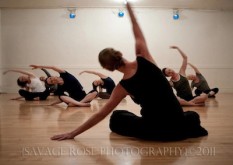Warming up is an essential part of the performance process.
While it’s widely recognized that we should warm up, it may be less understood how to do so effectively.
The amount of time spent warming up before a performance depends a lot on the demands of that particular performance.
Ask yourself these questions:
- Does the choreography require a lot of jumping, highly athletic movements, or extreme range of motion?
- How am I feeling today? Am I sore? Injured?
- How old am I?*
- Where in the performance does my part occur? How much time will pass between the warm-up class and actually dancing onstage?
- What type of floor am I dancing on?
- What shoes am I wearing for the performance?
- How cold is the theater?
All of these factors can and do influence how much you need to do to be properly prepared.

A warm-up class (assuming you have one), often occurs an hour or more before the start of the show, and your body only stays “warm” for about 5-15 minutes (depending on room temperature, clothing, etc) without continued activity. So it may be necessary to repeat a warm-up routine closer to when you perform.
In the exercise world, we divide warm-up into three basic categories: Passive, General, and Specific.
Passive Warm-up
Dancers have a reputation for wearing lots of clothing during their warm-ups. Aside from looking fashionable, all those scarves, plastic pants, leg warmers, socks, stocking caps, and shirts wrapped around your waist are serving an important purpose, namely, to provide a passive warm-up.
Heat aids such as heating pads, baths, or salves like Ben Gay or Tiger Balm are also considered a method of passive warm-up.
While these methods can assist in bringing heat and blood flow to the muscles, it should be noted that a good warm-up should not rely on them alone.
General Warm-up
Of the three types, the general warm-up is perhaps the most frequently neglected among dancers.
Consisting of 5-10 minutes of light cardiovascular exercise, a general warm-up is an important component that raises the heart rate, increases overall blood flow and oxygenation, and prepares the body for full range of motion activities. Taking a light jog, jumping jacks, and dynamic stretching are a few ways to accomplish a general warm-up, and should be repeated closer to when you will actually go onstage.
Seeing dancers bounce and rock back an forth in the wings, or prance and jump up and down are performance rituals that actually serve a purpose by warming the body back up and preparing it to perform.
While some might consider a ballet class to be a general warm-up, it’s probably a better idea to be a little warm before you do that first grand plié…
Specific Warm-up
A specific warm-up is meant to target the muscles in demand for the activity you are about to do. In weight lifting, this consists of a practice set of an exercise at a reduced load. Doing so brings blood flow to those targeted muscles and “rehearses” the movement (providing a mental refresher that will ultimately enhance your performance… but maybe that’s the topic of a different post).
In the case of dancers, I would consider a ballet barre and center to be more of a specific warm-up than general. Additional examples could be running through particular parts of your choreography or devising a few exercises that target the _____ (legs, feet, whatever will be utilized the most in that particular piece).
Closing thoughts
While it can be tempting to create a universal warm-up for every situation as part of your pre-performance ritual, the circumstances of each particular performance should inform how and what you do to get warm.
A comprehensive warm-up consists of general cardiovascular exercise, dynamic (rather than static) stretching, and skill or performance-specific movements.
Being vigilant about pre-performance warm-up prepares the dancer physically and mentally for the task at hand. More than just a ritual, warm-up serves a critical physiological role in helping you perform better and avoid injury.
Long story short: warm-up works.
Anecdotally, one of my students performed a vertical jump test twice, first without and then with a comprehensive warm-up. We found his jump height to be six inches higher after warming up!
Could we then theorize that warm-up could even lead to things like better critical reviews, more roles in the future, higher pay?
What do you think? We’d love to hear your thoughts on pre-show prep.
* Sorry… but it’s true. Older dancers should devote extra time to warming up.
Lauren Warnecke is a freelance writer and editor, focused on dance and cultural criticism in Chicago and across the Midwest. Lauren is the dance critic for the Chicago Tribune, editor of See Chicago Dance, and founder/editor of Art Intercepts, with bylines in Chicago Magazine, Milwaukee Magazine, St. Louis Magazine and Dance Media publications, among others. Holding degrees in dance and kinesiology, Lauren is an instructor of dance and exercise science at Loyola University Chicago. Read Lauren’s posts.

